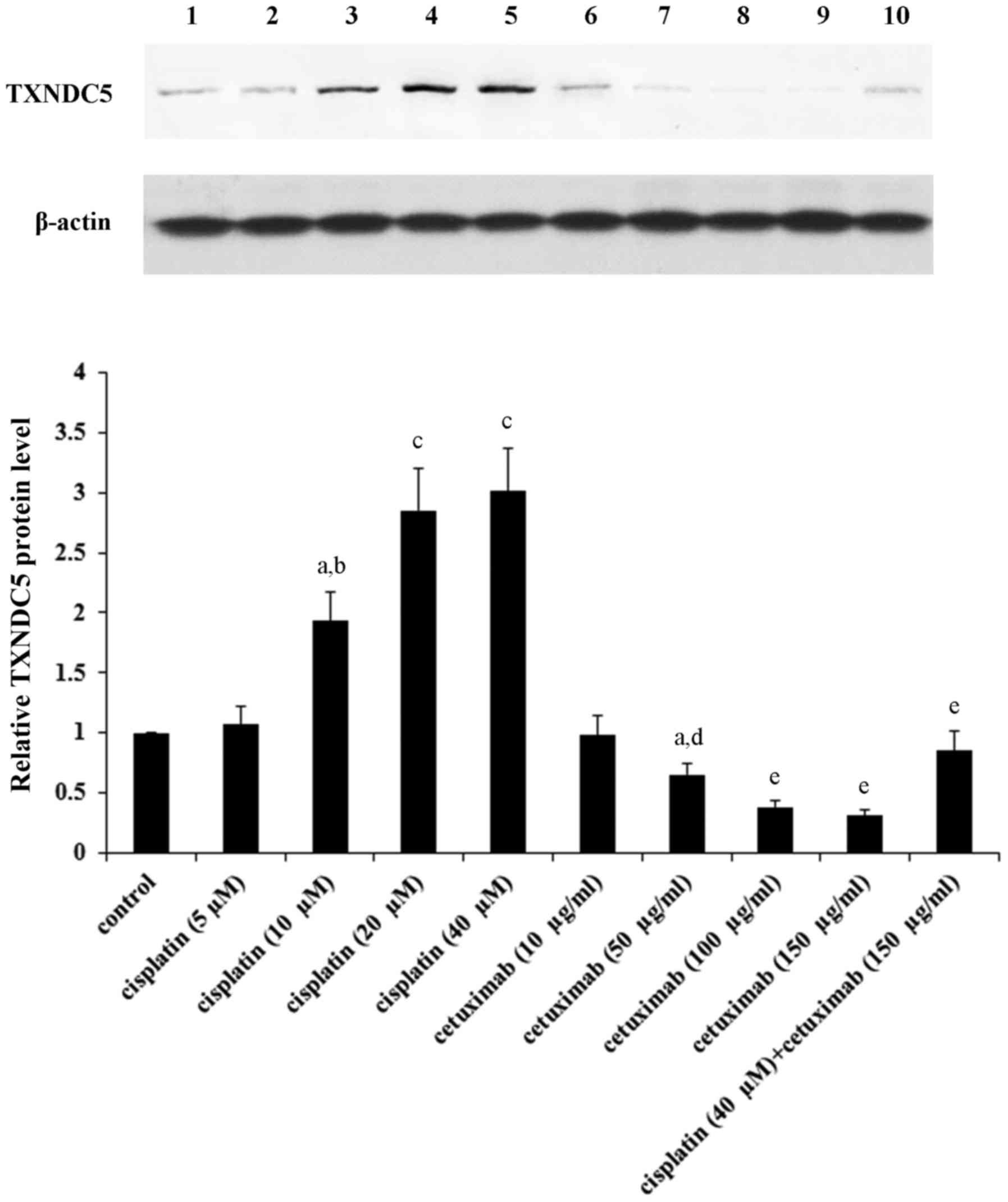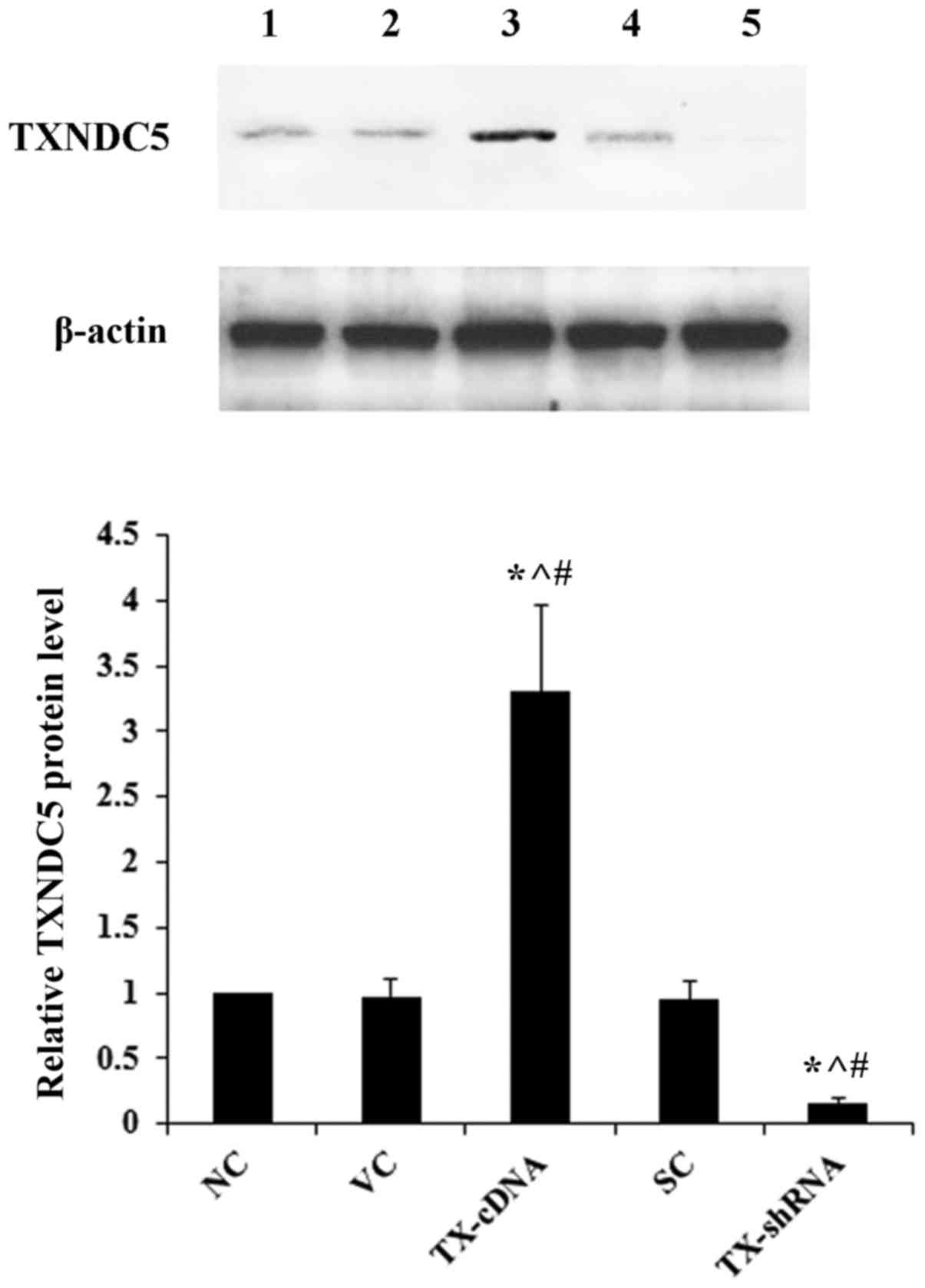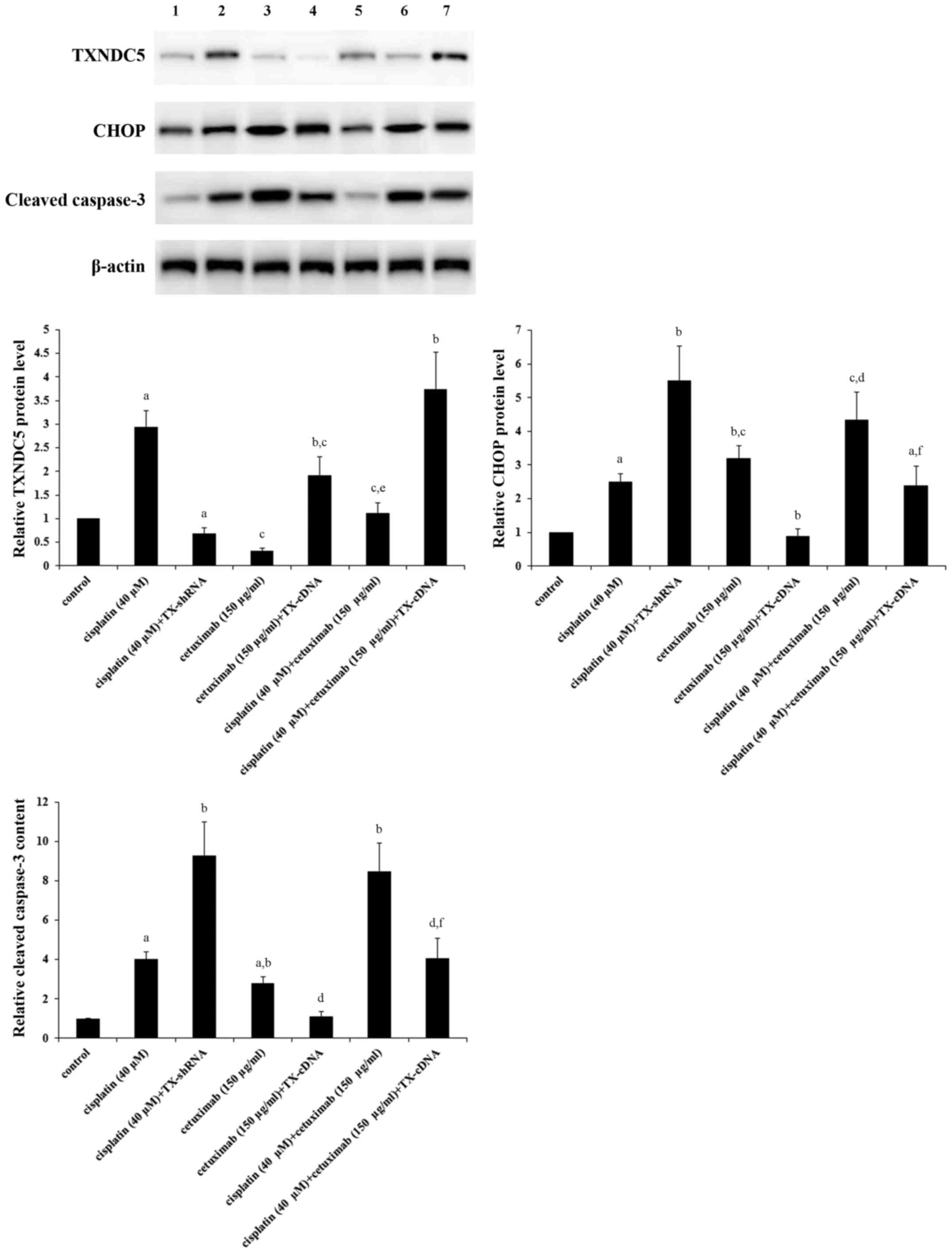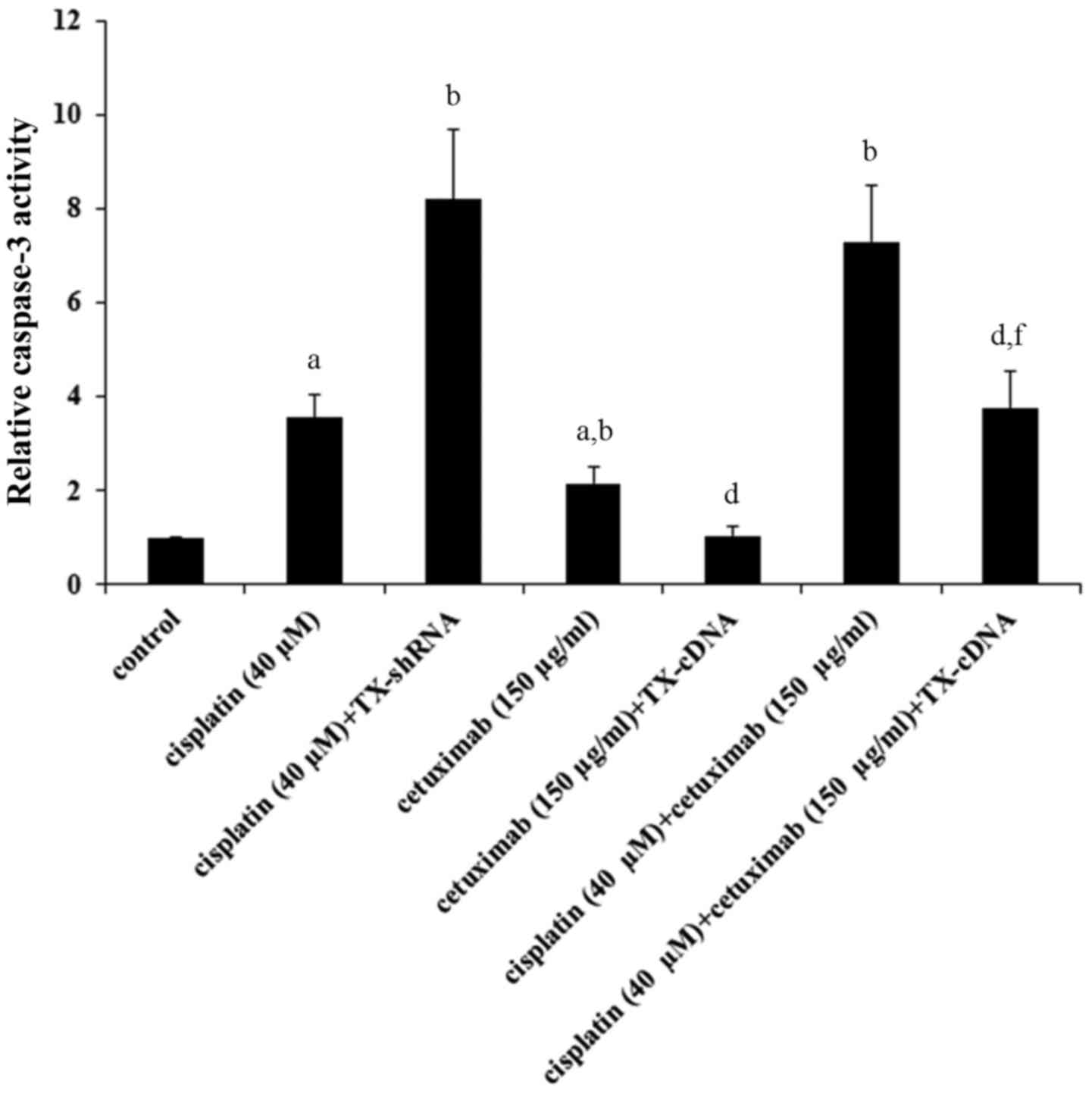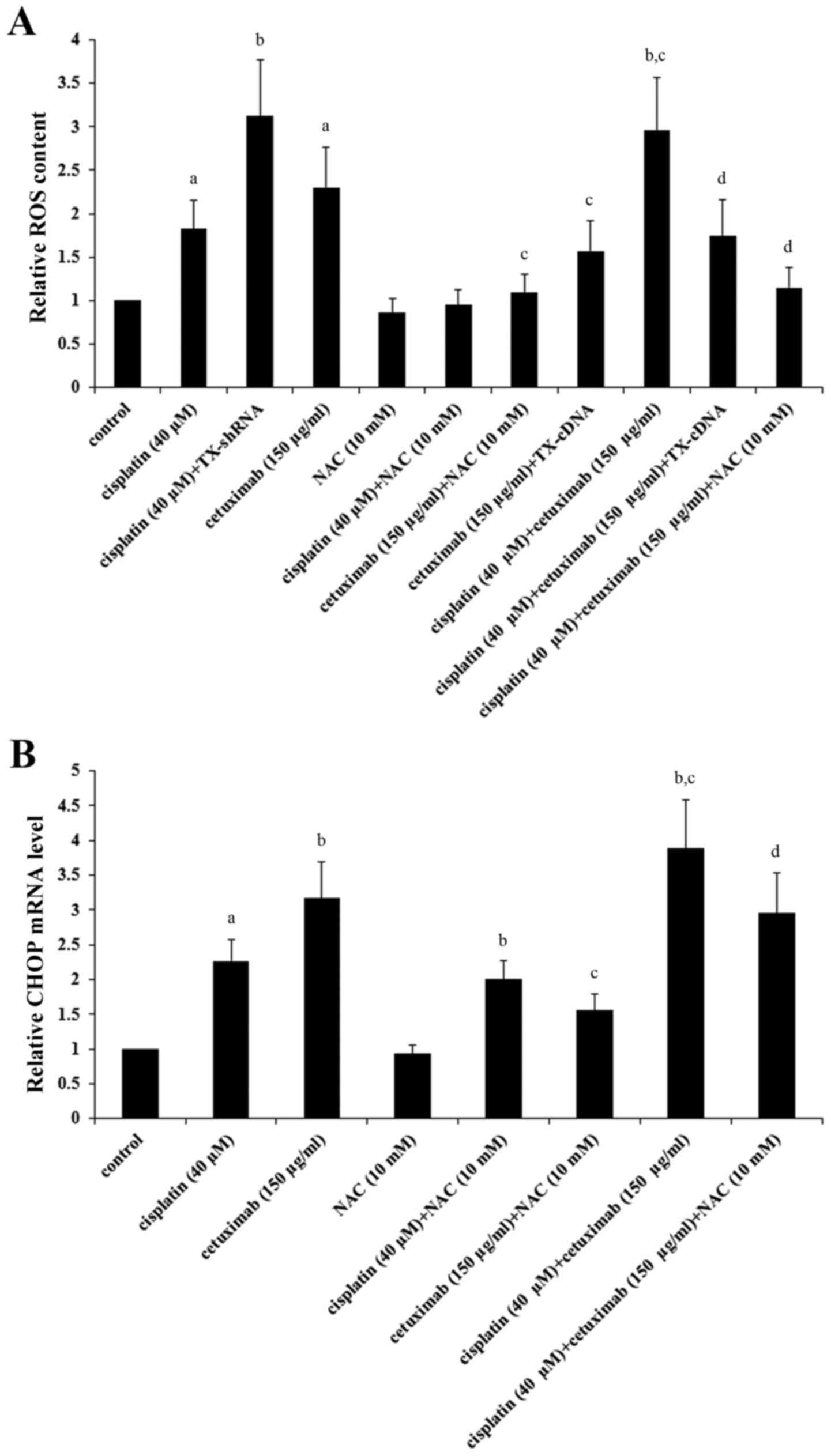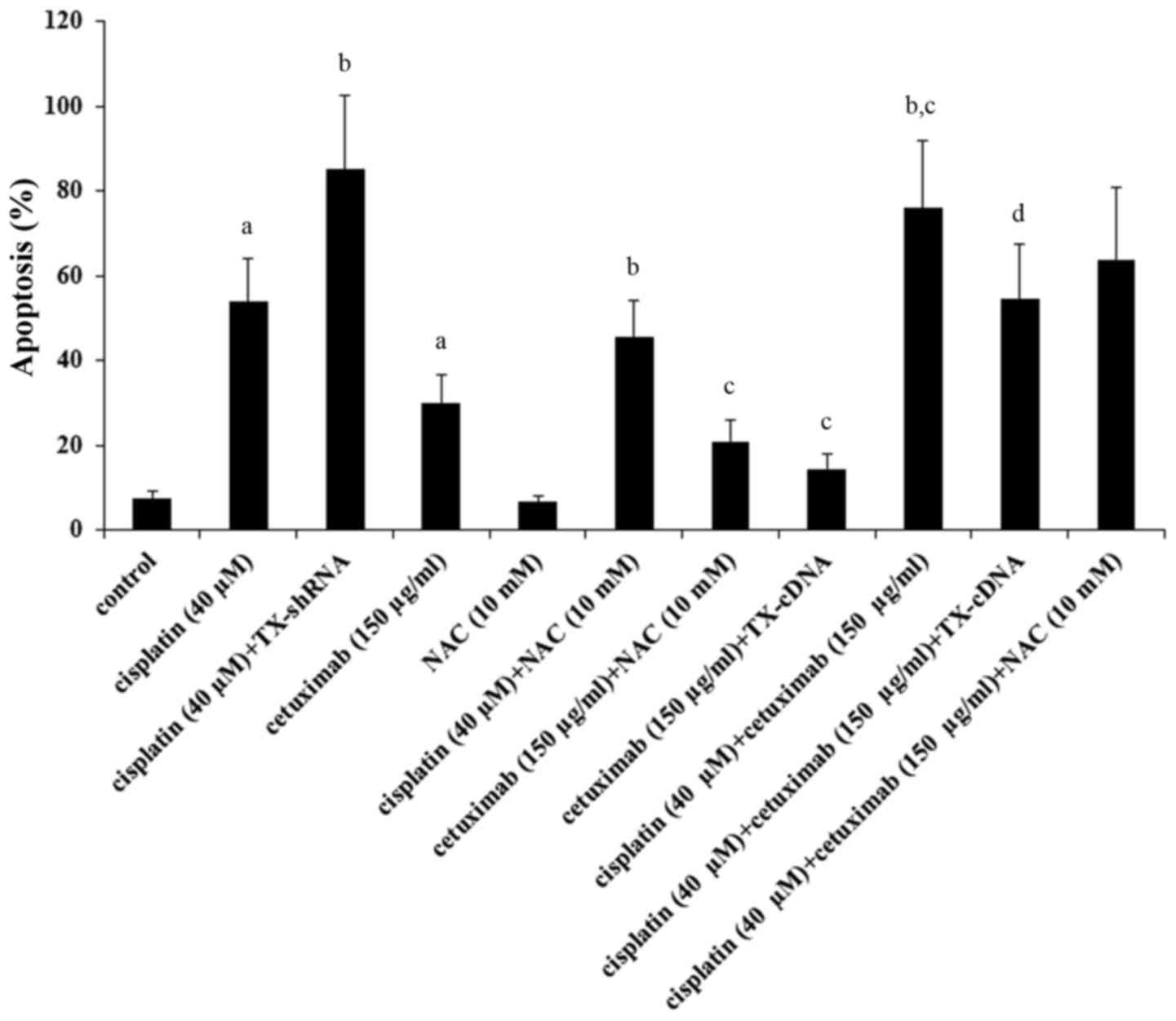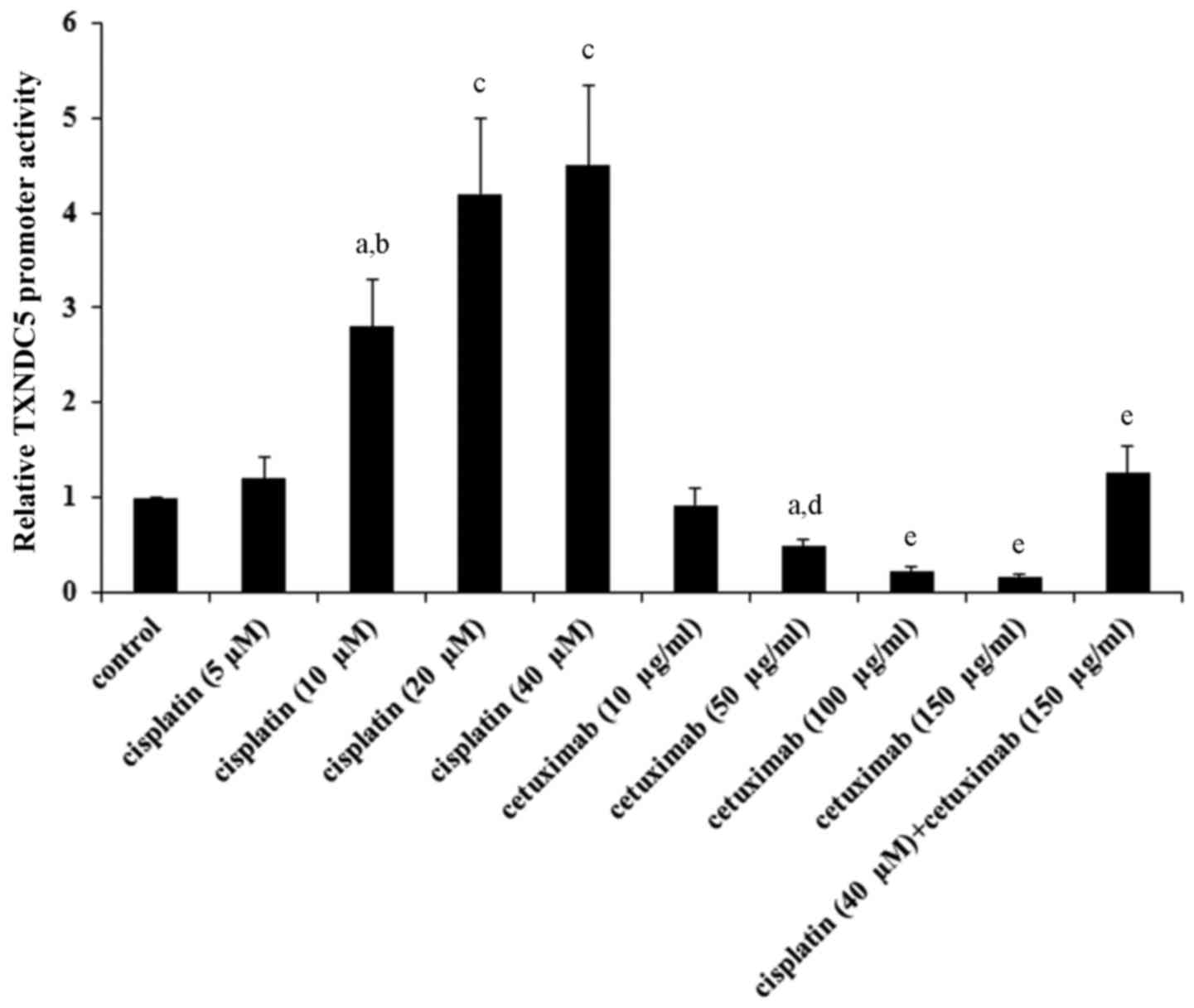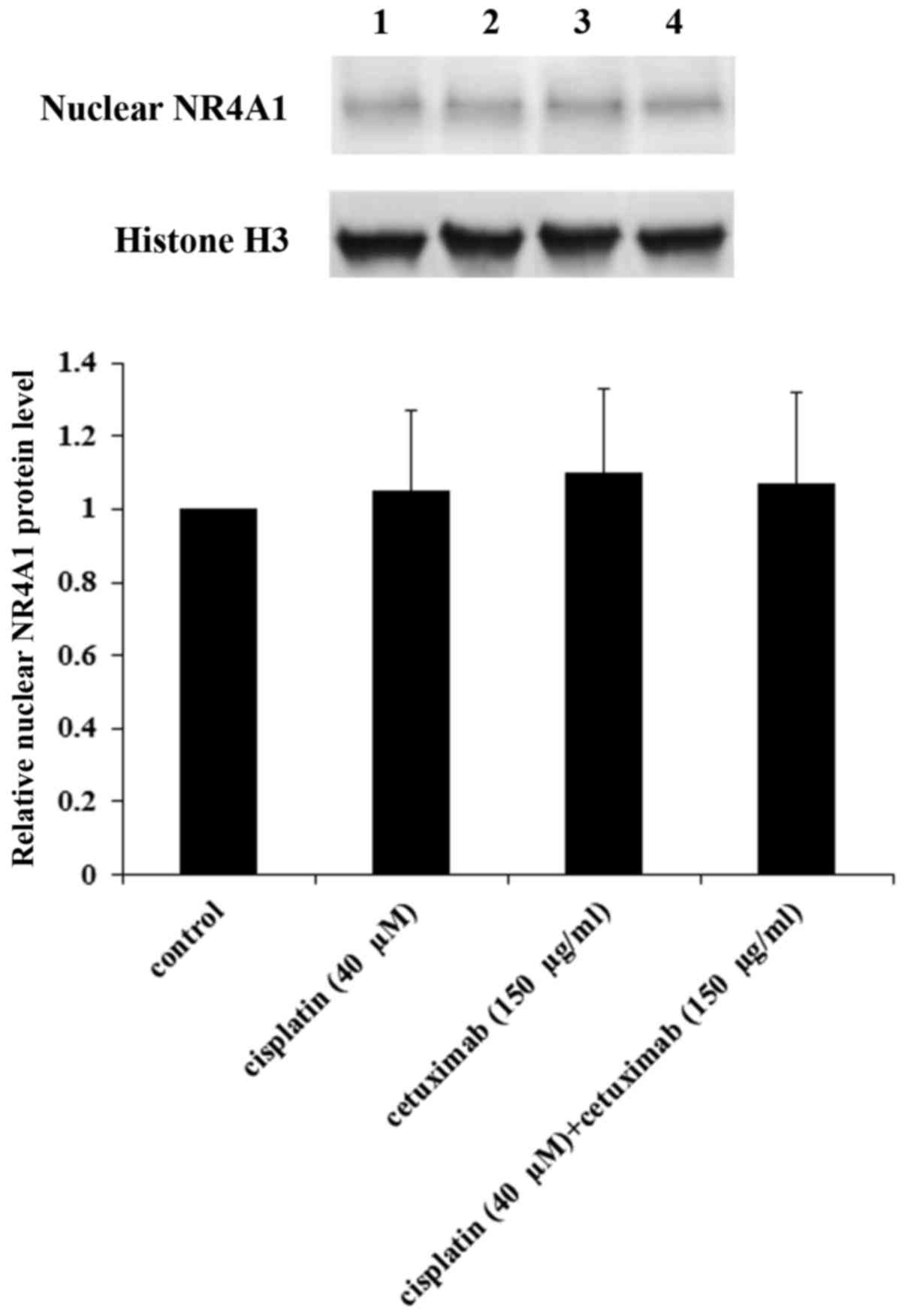Cetuximab enhances cisplatin-induced endoplasmic reticulum stress-associated apoptosis in laryngeal squamous cell carcinoma cells by inhibiting expression of TXNDC5
- Authors:
- Published online on: January 5, 2018 https://doi.org/10.3892/mmr.2018.8376
- Pages: 4767-4776
Abstract
Introduction
Laryngeal squamous cell carcinoma (LSCC), which accounts for ~14% of head and neck squamous cell carcinomas (SCCs) (1), is one of the most common carcinomas of the head and neck (1). Key features of LSCC include rapid progression, aggressive behavior, resistance to chemotherapy and poor prognosis (2,3). Patients with advanced LSCC are typically treated with a combination of surgery, chemotherapy and radiation therapy (4). Despite advances in treatment, the survival of patients with LSCC remains low, primarily due to its resistance to anticancer drugs (2,3). Therefore, it is imperative to identify novel methods to improve therapeutic efficacy for this disease.
Overexpression of epidermal growth factor receptor (EGFR) has been associated with tumor progression and resistance to chemotherapy and radiotherapy (5). EGFR and its ligands are overexpressed in head and neck SCCs including LSCC (5). Cetuximab, an anti-EGFR monoclonal humanized antibody, has been proved clinically effective in patients with recurrent or metastatic head and neck SCCs in combination with cisplatin-based chemotherapy (5,6). A recent in vitro study has demonstrated that cetuximab increases the therapeutic effect of cisplatin in LSCC cells (5).
As the most commonly used chemotherapeutic agent for the treatment of solid tumors, cisplatin has been proven effective for treatment of LSCC (7). However, the efficacy of cisplatin diminishes when LSCC develops resistance to it during the treatment process (7). It has been demonstrated that cisplatin has effects on multiple cellular targets in tumor cells in addition to nuclear DNA (8–10). Previous studies have revealed that cisplatin induces endoplasmic reticulum (ER) stress (11–13). ER stress-associated apoptosis is hypothesized to be a major cisplatin-induced pathway, which contributes to cisplatin cytotoxicity and is also involved in cisplatin resistance (14). Recent studies have suggested that EGFR signaling is also involved in ER stress-associated apoptosis (15,16). Miao et al (15) demonstrated that EGFR signaling protected cardiomyocytes from ER stress-associated apoptosis. However, Hong et al (16) demonstrated that inhibiting EGFR signaling triggered ER stress, which resulted in ER-mediated cell death.
ER is an essential subcellular compartment responsible for the synthesis and folding of proteins (17). Various physiological and pathological conditions may lead to ER stress, which results in an accumulation of unfolded or misfolded proteins in the ER lumen (18,19). This cellular stress subsequently causes an activation of the unfolded protein response, which induces the expression of chaperones and proteins involved in the recovery process (20). Moderate ER stress can be resolved and ER homeostasis restored to maintain cell survival, whereas severe and prolonged ER stress may induce cell apoptosis by activating downstream apoptotic signaling pathways (20). A decisive factor in this process is CCAAT/enhancer-binding protein homologous protein (CHOP), also known as growth arrest and DNA damage inducible gene (GADD153) (21). CHOP exhibits pro-apoptotic activity and is critical for triggering apoptosis in response to ER stress (22). Increased expression of CHOP activates caspases, integrates mitochondrial events and amplifies the death signal (21).
Thioredoxin domain-containing protein 5 (TXNDC5), a member of the disulfide isomerase family, is primarily expressed in the ER (23). It has been demonstrated that TXNDC5 protects cells from ER stress-induced apoptosis (24,25) by facilitating proteins to fold correctly via formation of disulfide bonds through its thioredoxin domains (26).
The present study for the first time, to the best of the authors' knowledge, investigated the interaction among cisplatin, cetuximab and TXNDC5 in ER stress-associated apoptosis in LSCC cells.
Materials and methods
Cell culture and treatments
The AMC-HN-8 human LSCC cell line was purchased from the Shanghai Institute of the Chinese Academy of Science (Shanghai, China), and cultured in RPMI 1640 media supplemented with 10% fetal bovine serum and 100 µM penicillin and streptomycin (Thermo Fisher Scientific, Inc., Waltham, MA, USA) in a humidified atmosphere containing 5% CO2 at 37°C. The cells were treated with cisplatin (Sigma-Aldrich; Merck KGaA, Darmstadt, Germany) at 5, 10, 20 and 40 µM and/or cetuximab (Merck KGaA) at 10, 50, 100 and 150 µg/ml for 12, 24, 36 and 48 h, in the presence or absence of 10 mM reactive oxygen species (ROS) scavenger/antagonist N-acetylcysteine (NAC; Sigma-Aldrich; Merck KGaA). For TXNDC5 knockdown, AMC-HN-8 cells were transduced with human ERp46/TXNDC5 lentiviral particles (sc-60601-V; Santa Cruz Biotechnology, Inc., Dallas, TX, USA), with cells transduced with control short hairpin RNA (shRNA) lentiviral particles (sc-108080; Santa Cruz Biotechnology, Inc.) as a control. For TXNDC5 overexpression, human full length TXNDC5 cDNA clone (SC109657) was purchased from Origene Technologies, Inc. (Beijing, China) and subcloned into pcDNA 3.1 expression vector (V79020; Thermo Fisher Scientific, Inc.); then AMC-HN-8 cells were transfected with the TXNDC5-expressing vector using Lipofectamine 3000 transfection reagent (L3000008; Thermo Fisher Scientific, Inc.), according to the manufacturer's protocol. Empty expression vector was used as the control. The cells were subject to subsequent experiments 24 h following transduction/transfection.
Real-time reverse transcription-quantitative polymerase chain reaction (RT-qPCR)
RNA was prepared from AMC-HN-8 cells using TRIzol reagent (Thermo Fisher Scientific, Inc.) followed by purification with TURBO DNA-free System (Ambion, Austin, TX, USA). cDNA was synthesized using SuperScript II reverse transcriptase (Thermo Fisher Scientific, Inc.) and random hexamer primers (Thermo Fisher Scientific, Inc.). RT-qPCR was performed using an ABI-PRISM 7700 Sequence Detection System (Applied Biosystems; Thermo Fisher Scientific, Inc.) and the fluorescent dye SYBR Green Master Mix (Thermo Fisher Scientific, Inc.), according to the manufacturer's protocol. The primers used were as follows: Forward, 5′-GGGTCAAGATCGCCGAAGTA-3′ and reverse, 5′GCCTCCACTGTGCTCACTGA3′ for TXNDC5; and forward, 5′CCCTGTAATTGGAATGAGTCCAC3′ and reverse, 5′GCTGGAATTACCGCGGCT3′ for 18S rRNA. The PCR amplification condition was: Initial denaturation for 20 sec at 95°C, 40 cycles of denaturation for 3 sec at 95°C, annealing for 30 sec at 60°C. Relative quantification of the TXNDC5 expression level was determined using the 2−ΔΔCq method (27) and normalized against that of 18S rRNA in the same sample. Each experiment was repeated three independent times in duplicate.
Western blot analysis
Whole cell lysates were extracted by incubating AMC-HN-8 cells with lysis buffer [50 mM Tris-HCl (pH 7.2), 150 mM NaCl, l% (v/v) Triton X-100, 1 mM sodium orthovanadate, 50 mM sodium pyrophosphate, 100 mM sodium fluoride, 0.01% (v/v) aprotinin, 4 µg/ml pepstatin A, 10 µg/ml leupeptin and 1 mM phenylmethanesulfonyl fluoride; all Sigma-Aldrich; Merck KGaA] on ice for 30 min and removing cell debris by centrifugation at 2,000 × g for 15 min at 4°C. For the detection of nuclear receptor subfamily 4 group A member 1 (NR4A1), nuclear extracts were prepared as previously described (28). Equal amount of proteins (7 µg) for each sample were separated by 10% SDS-PAGE and blotted onto a polyvinylidene difluoride microporous membrane (EMD Millipore, Billerica, MA, USA). The membranes were blocked with 5% skimmed milk powder in TBS containing 0.1% Tween-20 (SRE0031; Sigma-Aldrich; Merck KGaA) for 2 h at room temperature, and incubated for 1 h at room temperature with a 1:1,000 dilution of goat anti-human ERp46/TXNDC5 polyclonal antibody (sc-49660), mouse anti-mouse GADD153/CHOP monoclonal antibody (sc-7351), rabbit anti-human cleaved caspase-3 p11 polyclonal antibody (sc-22171-R), mouse anti-human β-actin monoclonal antibody (sc-130301), mouse anti-human NR4A1/Nur77 monoclonal antibody (sc-365113), or goat anti-human histone H3 polyclonal antibody (sc-8654; all Santa Cruz Biotechnology, Inc.). Membranes were subsequently washed in TBST (Sigma-Aldrich; Merck KGaA) for 5 min three times, and probed using bovine anti-goat (sc-2378), bovine anti-mouse (sc-2371) or bovine anti-rabbit (sc-2370; all Santa Cruz Biotechnology, Inc.) horseradish peroxidase-conjugated secondary antibodies at a 1:5,000 dilution for 1 h at room temperature. Protein bands were visualized by enhanced chemiluminescence (GE Healthcare Life Sciences, Little Chalfont, UK) using the ChemiDoc Touch Imaging system (Bio-Rad Laboratories, Inc., Hercules, CA, USA) and Image Lab Touch software version 4.1 (Bio-Rad Laboratories, Inc.) for image acquisition and densitometric analysis. Three independent experiments were performed.
Intracellular ROS detection
ROS were measured using the Dichlorodihydrofluorescein Diacetate (DCFDA) Cellular Reactive Oxygen Species Detection Assay kit (ab113851; Abcam, Cambridge, UK), according to the manufacturer's protocol. Cells were plated at 7×104 cells/well in black 96-well plates and incubated with 25 µM DCFDA for 45 min at 37°C. Fluorescence was detected using a Victor3 1420 Multilabel Counter (PerkinElmer, Inc., Shanghai, China).
Caspase-3 activity assay
The activity of caspase-3 was determined using a colorimetric Caspase-3 Assay kit (ab39401; Abcam, Cambridge, MA, USA). The assays were performed in 96-well plates by incubating 20 µl cell lysate protein/sample in 70 µl reaction buffer [1% NP-40, 20 mM Tris-HCl (pH 7.5), 137 mM Nad and 10% glycerol] containing 10 µl caspase-3 substrate (2 mM). The lysates were subsequently incubated at 37°C for 6 h, following which the samples were assayed using an iMark Microplate Absorbance Reader (1681130; Bio-Rad Laboratories, Inc.) at 405 nm. Each experiment was repeated three independent times in duplicate.
Cellular apoptosis assay
AMC-HN-8 cells with or without TXNDC5 knockdown or overexpression were cultured at 7×104 cells/well in 96-well tissue culture plates in the presence of cisplatin (40 µM) and/or cetuximab (150 µg/ml) for 48 h at 37°C. Cellular apoptosis was measured with a microplate reader-based TiterTACS in situ apoptosis detection kit (4822–96-K; R&D systems, Inc., Minneapolis, MN, USA), according to manufacturer's protocol. Each experiment was repeated three independent times in duplicate.
Luciferase reporter assay
AMC-HN-8 cells were transfected with a commercially available human TXNDC5 gene promoter/pLightSwitch_Prom luciferase reporter (S709642; SwitchGear Genomics, Menlo Park, CA, USA) using Lipofectamine 3000 transfection reagent (Thermo Fisher Scientific, Inc.) for 24 h at 37°C, and subsequently treated with cisplatin (Sigma-Aldrich; Merck KGaA) at 5, 10, 20 and 40 µM and/or cetuximab (Merck KGaA) at 10, 50, 100 and 150 µg/ml for 48 h 37°C. Luciferase assays were performed with the LightSwitch Luciferase Assay kit (LS010; SwitchGear Genomics) according to the manufacturer's protocol. Plasmid PRL-CMV (Promega Corporation, Madison, WI, USA) encoding Renilla luciferase (at 1/5 molar ratio to the reporter plasmid) was co-transfected with the reporter plasmid in each transfection as an internal control for data normalization. Each experiment was repeated three independent times in duplicate.
Statistical analysis
Statistical analyses were performed with SPSS software version 10.0 (SPSS Inc., Chicago, IL, USA). All data values were expressed as the mean ± standard deviation. Comparisons of means among multiple groups were performed using one-way analysis of variance followed by post hoc pairwise comparisons using Tukey's test. P<0.05 was considered to indicate a statistically significant difference.
Results
Cisplatin and cetuximab increase and decrease the expression of TXNDC5 in human LSCC cells, respectively
To examine the effects of cisplatin and cetuximab on the expression of TXNDC5 in LSCC cells, AMC-HN-8 human LSCC cells were treated with cisplatin (5, 10, 20 and 40 µM) or cetuximab (10, 50, 100 and 150 µg/ml) for 12, 24, 36 and 48 h. As demonstrated in Table I, cisplatin concentration- and time-dependently increased the mRNA level of TXNDC5 in AMC-HN-8 cells, until it reached a plateau at 20–40 µM following 36–48 h of treatment. As demonstrated in Table II, cetuximab concentration- and time-dependently decreased the mRNA level of TXNDC5 in AMC-HN-8 cells, until it reached a plateau at 100–150 µg/ml following 36–48 h of treatment. Western blot analyses confirmed that in AMC-HN-8 cells under 48 h of treatment, cisplatin and cetuximab concentration-dependently increased and decreased the protein levels of TXNDC5 until reaching a plateau at 20–40 µM and 100–150 µg/ml, respectively (Fig. 1).
Cetuximab enhances cisplatin-induced ER stress-associated apoptosis in LSCC cells by inhibiting expression of TXNDC5
It has been reported that cisplatin induces ER stress-associated apoptosis (20,21), while TXNDC5 has been demonstrated to protect cells from ER stress-induced apoptosis (24,25). Recent studies have suggested that EGFR signaling is also involved in ER stress-associated apoptosis (15,16). To investigate the functional role of TXNDC5 in the effects of cisplatin and cetuximab on ER stress in LSCC cells, TXNDC5 was overexpressed and knocked down in AMC-HN-8 cells, respectively. As demonstrated in Fig. 2, compared with the controls, TXNDC5 was successfully overexpressed >3-fold and knocked down by >80% in AMC-HN-8 cells. As demonstrated in Fig. 3, compared with the control, cisplatin (40 µM) increased the expression of TXNDC5 by ~3-fold, which was completely eliminated by knocking down TXNDC5; however, cetuximab (150 µg/ml) decreased the expression of TXNDC5 by ~70%, which was completely reversed by overexpressing TXNDC5; combined treatment with cisplatin (40 µM) and cetuximab (150 µg/ml) restored the expression of TXNDC5 to the control level, compared with their individual effect. The expression of CHOP, a decisive factor in ER-stress-associated apoptosis (21,22), was increased by ~2.5-fold by cisplatin; this effect of cisplatin was more than doubled by TXNDC5 knockdown (Fig. 3). Cetuximab increased the expression of CHOP by ~3-fold, which was completely eliminated by TXNDC5 overexpression (Fig. 3). Cisplatin and cetuximab demonstrated a combinatorial effect on increasing the expression of CHOP, which was decreased by ~45% by TXNDC5 overexpression. The level of cleaved caspase-3, a major caspase activated in apoptotic cells (29), was increased by ~4-fold by cisplatin; this effect of cisplatin was increased by >2-fold by TXNDC5 knockdown (Fig. 3). Cetuximab increased the level of cleaved caspase-3 by ~3-fold, which was completely eliminated by TXNDC5 overexpression (Fig. 3). Cisplatin and cetuximab demonstrated a combinatorial effect on increasing the level of cleaved/activated caspase-3, which was decreased by ~50% by TXNDC5 overexpression. The findings were confirmed by directly measuring the caspase-3 activity (Fig. 4), which demonstrated a similar data trend.
It has been reported that TXNCD5 maintains levels of cellular reductants and that drug- or siRNA-induced downregulation of TXNDC5 induces ROS, which in turn activates ER stress and CHOP expression (30). Therefore, the interactive effects of TXNDC5, cisplatin, cetuximab and ROS scavenger/antagonist NAC on ROS production and CHOP expression in LSCC cells were investigated. As demonstrated in Fig. 5A, cisplatin (40 µM) and cetuximab (150 µg/ml) significantly induced ROS in AMC-HN-8 cells (P<0.05), which was respectively enhanced by TNXDC5 knockdown and inhibited by TXNDC5 overexpression; cisplatin and cetuximab exhibited a combinatorial effect on inducing ROS, which was significantly eliminated by TXNDC5 overexpression or NAC (P<0.05). As demonstrated in Fig. 5B, NAC significantly decreased cisplatin- and cetuximab-induced CHOP expression in addition to the combinatorial promoting effect of cisplatin and cetuximab on CHOP expression in AMC-HN-8 cells (P<0.05).
As demonstrated in Fig. 6, treatment with cisplatin (40 µM) for 48 h resulted in 56% of apoptosis, which was increased to 82% by TXNDC5 knockdown and decreased to 43% by NAC; treatment with cetuximab (150 µg/ml) for 48 h resulted in 30% apoptosis, which was brought down to 14.5% by TXNDC5 and to 21% by NAC. Combined treatment with cisplatin (40 µM) and cetuximab (150 µg/ml) resulted in 76% apoptosis, which was brought down to 54% by TXNDC5 overexpression and to 63% by NAC. Analyses of the data revealed that knockdown of TXNDC5 augmented the apoptotic effect of cisplatin by ~54% [(82–56%)/(56–7.7%)=53.8%; basal apoptosis level=7.7%]; overexpression of TXNDC5 reduced the apoptotic effect of cetuximab by ~70% [(30–14.5%)/(30–7.7%)=69.5%]; the effect of TXNDC5 was primarily mediated by inhibiting ROS production (~59%) [(76–63%)/(76–54%)=59.1%].
The above findings suggested that cetuximab enhanced the apoptotic effect of cisplatin on LSCC cells by promoting ER stress-associated apoptosis primarily via inhibiting expression of TXNDC5 and thereby increasing ROS production.
Cisplatin and cetuximab exhibit opposing effects on TXNDC5 gene promoter
As indicated in Tables I and II, cisplatin and cetuximab exhibited opposing effects on the TXNDC5 mRNA level, suggesting that the two drugs may affect the TXNDC5 gene promoter activity. AMC-HN-8 cells were transfected with a human TXNDC5 gene promoter/luciferase reporter, and the cells were treated with cisplatin (5, 10, 20 and 40 µM) or cetuximab (10, 50, 100 and 150 µg/ml) for 48 h. As demonstrated in Fig. 7, cisplatin and cetuximab concentration-dependently increased and decreased the TXNDC5 promoter activity, respectively. Combined treatment with cisplatin (40 µM) and cetuximab (150 µg/ml) restored the TXNDC5 promoter activity to the control level, compared with their individual effect (Fig. 7). The findings suggested that cisplatin and cetuximab exhibit opposing effects on the TXNDC5 gene promoter.
As TXNDC5 expression is reportedly regulated by the orphan nuclear receptor NR4A1 in cancer cell lines (30–32) and NR4A1 also serves a role in cisplatin-induced responses (33,34), it was subsequently examined whether cisplatin and/or cetuximab exhibited an effect on NR4A1 levels in the nucleus of AMC-HN-8 cells. As demonstrated in Fig. 8, cisplatin and cetuximab demonstrated no significant effects on the nuclear NR4A1 protein level, suggesting that NR4A1 did not serve a role in the regulatory effects of cisplatin and cetuximab on the TXNDC5 gene promoter.
Discussion
Cisplatin and cetuximab have been used for the treatment of LSCC (5,6). It has been demonstrated that cisplatin and inhibition of EGFR signaling may induce ER stress-associated apoptosis (11–16). However, ER protein TXNDC5 reportedly protects cells from ER stress-induced apoptosis (24,25). The present study provided the first evidence, to the best of the authors' knowledge, that: i) While inducing ER stress-associated apoptosis, cisplatin also induces expression of TXNDC5 in LSCC cells; ii) cetuximab inhibits the expression of TXNDC5 in LSCC cells; and iii) cetuximab enhances the apoptotic effect of cisplatin on LSCC cells primarily via inhibiting expression of TXNDC5.
As the previously widely used Hep-2 cell line has been identified to be dominated by HeLa cell contamination rather than LSCC cells (35), only the AMC-HN-8 human LSCC cell line was used as a cell model in the study (36). In agreement with previous studies demonstrating that cisplatin induces ER stress-associated apoptosis (14,21), cisplatin induced ER stress-associated apoptosis in LSCC cells in the present study, as evidenced by elevated levels of CHOP, caspase activity and apoptosis. Cisplatin also induced TXNDC5, an ER protein protective against ER stress-associated apoptosis (23–26); this may be a protective response of LSCC cells to promote survival under cisplatin-induced ER stress. The direct effect of this response was to decrease cisplatin-induced apoptosis, which was demonstrated by: i) The marked enhancement of the apoptotic effect of cisplatin following TXNDC5 knockdown; and ii) cetuximab, which inhibited the expression of TXNDC5, markedly enhanced the apoptotic effect of cisplatin and this effect was eliminated by overexpressing TXNDC5. Knockdown of TXNDC5 augmented the apoptotic effect of cisplatin by ~54%, suggesting that ER stress-associated apoptosis is a major mechanism underlying the apoptotic effect of cisplatin on LSCC cells and that TXNDC5 is a critical factor in this process.
It has been reported that cetuximab effectively antagonizes EGFR signaling (5,6,37) and that inhibition of EGFR signaling induces ER stress-associated apoptosis (15,16). In agreement with these previous reports, cetuximab induced ER stress-associated apoptosis in LSCC cells in the present study, as evidenced by elevated levels of CHOP, caspase activity and apoptosis. Overexpression of TXNDC5 reduced the apoptotic effect of cetuximab by ~70%, suggesting that ER stress-associated apoptosis is a major mechanism underlying the apoptotic effect of cetuximab on LSCC cells and that TXNDC5 is a critical factor in this process.
In agreement with previous studies demonstrating that TXNDC5 protects cells from ER stress-induced apoptosis (24,25), the present study demonstrated by overexpression and knockdown experiments that TXNDC5 is an effective protective/survival factor against cisplatin- and cetuximab-induced ER stress-associated apoptosis. Therefore, TXNDC5 may be a new potential therapeutic target for LSCC and other cancers. In the present study, cetuximab enhanced the apoptotic effect of cisplatin on LSCC cells primarily by inhibiting the expression of TXNDC5 and the overexpression of TXNDC5 eliminated the enhancing effect of cetuximab. It may be worthwhile to examine whether cetuximab in combination with ER stress-inducing chemotherapeutic agents other than cisplatin may benefit patients with LSCC or other cancers. In addition, as radiotherapy is a major treatment for a number of types of cancer, including advanced LSCC (4), and induces ER stress in tumor cells (38,39), cetuximab in combination with radiotherapy may benefit patients with advanced LSCC or other cancer types.
TXNDC5 reportedly facilitates the correct folding of proteins via the formation of disulfide bonds through its thioredoxin domains, thereby alleviating ER stress and protecting cells from ER stress-associated apoptosis (24–26). It has also been demonstrated that TXNCD5 maintains levels of cellular reductants and that drug- or siRNA-induced downregulation of TXNDC5 induces ROS, which in turn activates ER stress and CHOP expression (30). Consistent with previous reports, the present study identified that cisplatin and cetuximab significantly induced ROS and CHOP expression in AMC-HN-8 cells, which were respectively enhanced by TNXDC5 knockdown and inhibited by TXNDC5 overexpression; an ROS scavenger/antagonist significantly decreased cisplatin- and cetuximab-induced ROS and CHOP expression. Apoptosis analysis suggested that 59% of TXNDC5 overexpression-induced inhibition of the apoptotic effect of cetuximab may be attributed to it inhibiting ROS production. The present results suggest that cetuximab enhances cisplatin-induced ER stress-associated apoptosis primarily by regulating TXNDC5-mediated inhibition of ROS production. Nevertheless, the other mechanisms involved in how TXNDC5 functions to lessen cisplatin- and cetuximab-induced ER stress in LSCC cells remain to be elucidated and require future studies. The present study identified that cisplatin and cetuximab exhibited opposing effects on the TXNDC5 gene promoter, suggesting that cisplatin and cetuximab regulate the expression of TXNDC5 at the gene transcription/promoter level. The orphan nuclear receptor NR4A1 reportedly regulates TNXDC5 expression (30–32) and also serves a role in cisplatin-induced responses (33,34). However, as cisplatin and cetuximab demonstrated no significant effects on the nuclear NR4A1 protein level, it is unlikely that NR4A1 mediates the regulatory effects of cisplatin and cetuximab on the TXNDC5 gene promoter. It is hypothesized that the mechanisms underlying transcriptional regulation of TXNDC5 expression may be investigated in future studies.
In conclusion, the results of the present study suggested that ER stress-associated apoptosis is a major mechanism underlying the apoptotic effect of cisplatin and cetuximab on LSCC cells. Cetuximab enhances cisplatin-induced ER stress-associated apoptosis in LSCC cells primarily by inhibiting the expression of TXNDC5 and thereby increasing ROS production. Cisplatin and cetuximab exhibited stimulatory and inhibitory effects on the TXNDC5 gene promoter, respectively. The present study presented a novel understanding of the pharmacological effects of cisplatin and cetuximab on LSCC. The present study also suggested that TXNDC5 may be a potential novel therapeutic target for LSCC.
Acknowledgements
The present study was funded by the Science and Technology Foundation of Hunan Province, China (grant no. 2015AK2056).
References
|
Jemal A, Siegel R, Ward E, Hao Y, Xu J and Thun MJ: Cancer statistics, 2009. CA Cancer J Clin. 59:225–249. 2009. View Article : Google Scholar : PubMed/NCBI | |
|
Mnejja M, Hammami B, Bougacha L, Chakroun A, Charfeddine I, Khabir A, Boudaoura T and Ghorbel A: Occult lymph node metastasis in laryngeal squamous cell carcinoma: Therapeutic and prognostic impact. Eur Ann Otorhinolaryngol Head Neck Dis. 127:173–176. 2010. View Article : Google Scholar : PubMed/NCBI | |
|
Amar A, Chedid HM, Franzi SA and Rapoport A: Diagnostic and therapeutic delay in patients with larynx cancer at a reference public hospital. Braz J Otorhinolaryngol. 76:700–703. 2010. View Article : Google Scholar : PubMed/NCBI | |
|
Hitt R, López-Pousa A, Martinez-Trufero J, Escrig V, Carles J, Rizo A, Isla D, Vega ME, Marti JL, Lobo F, et al: Phase III study comparing cisplatin plus fluorouracil to paclitaxel, cisplatin, and fluorouracil induction chemotherapy followed by chemoradiotherapy in locally advanced head and neck cancer. J Clin Oncol. 23:8636–8645. 2005. View Article : Google Scholar : PubMed/NCBI | |
|
Bussu F, Pozzoli G, Giglia V, Rizzo D, Limongelli A, De Corso E, Graziani C, Paludetti G, Navarra P and Almadori G: Effects of the administration of epidermal growth factor receptor specific inhibitor cetuximab, alone and in combination with cisplatin, on proliferation and apoptosis of Hep-2 laryngeal cancer cells. J Laryngol Otol. 128:902–908. 2014. View Article : Google Scholar : PubMed/NCBI | |
|
Burtness B, Goldwasser MA, Flood W, Mattar B and Forastiere AA; Eastern Cooperative Oncology Group, : Phase III randomized trial of cisplatin plus placebo compared with cisplatin plus cetuximab in metastatic/recurrent head and neck cancer: An Eastern Cooperative Oncology Group study. J Clin Oncol. 23:8646–8654. 2005. View Article : Google Scholar : PubMed/NCBI | |
|
Lv X, Song DM, Niu YH and Wang BS: Inhibition of heme oxygenase-1 enhances the chemosensitivity of laryngeal squamous cell cancer Hep-2 cells to cisplatin. Apoptosis. 21:489–501. 2016. View Article : Google Scholar : PubMed/NCBI | |
|
Macciò A and Madeddu C: Cisplatin: An old drug with a newfound efficacy - from mechanisms of action to cytotoxicity. Expert Opin Pharmacother. 14:1839–1857. 2013. View Article : Google Scholar : PubMed/NCBI | |
|
Sancho-Martínez SM, Prieto-García L, Prieto M, López-Novoa JM and López-Hernández FJ: Subcellular targets of cisplatin cytotoxicity: An integrated view. Pharmacol Ther. 136:35–55. 2012. View Article : Google Scholar : PubMed/NCBI | |
|
Yu F, Megyesi J and Price PM: Cytoplasmic initiation of cisplatin cytotoxicity. Am J Physiol Renal Physiol. 295:F44–F52. 2008. View Article : Google Scholar : PubMed/NCBI | |
|
Peyrou M, Hanna PE and Cribb AE: Cisplatin, gentamicin, and p-aminophenol induce markers of endoplasmic reticulum stress in the rat kidneys. Toxicol Sci. 99:346–353. 2007. View Article : Google Scholar : PubMed/NCBI | |
|
Mandic A, Hansson J, Linder S and Shoshan MC: Cisplatin induces endoplasmic reticulum stress and nucleus-independent apoptotic signaling. J Biol Chem. 278:9100–9106. 2003. View Article : Google Scholar : PubMed/NCBI | |
|
Liu H and Baliga R: Endoplasmic reticulum stress-associated caspase 12 mediates cisplatin-induced LLC-PK1 cell apoptosis. J Am Soc Nephrol. 16:1985–1992. 2005. View Article : Google Scholar : PubMed/NCBI | |
|
Xu Y, Wang C and Li Z: A new strategy of promoting cisplatin chemotherapeutic efficiency by targeting endoplasmic reticulum stress. Mol Clin Oncol. 2:3–7. 2014. View Article : Google Scholar : PubMed/NCBI | |
|
Miao Y, Bi XY, Zhao M, Jiang HK, Liu JJ, Li DL, Yu XJ, Yang YH, Huang N and Zang WJ: Acetylcholine inhibits tumor necrosis factor α activated endoplasmic reticulum apoptotic pathway via EGFR-PI3K signaling in cardiomyocytes. J Cell Physiol. 230:767–774. 2015. View Article : Google Scholar : PubMed/NCBI | |
|
Hong S, Gu Y, Gao Z, Guo L, Guo W, Wu X, Shen Y, Sun Y, Wu X and Xu Q: EGFR inhibitor-driven endoplasmic reticulum stress-mediated injury on intestinal epithelial cells. Life Sci. 119:28–33. 2014. View Article : Google Scholar : PubMed/NCBI | |
|
Walter P and Ron D: The unfolded protein response: From stress pathway to homeostatic regulation. Science. 334:1081–1086. 2011. View Article : Google Scholar : PubMed/NCBI | |
|
Berridge MJ: The endoplasmic reticulum: A multifunctional signaling organelle. Cell Calcium. 32:235–249. 2002. View Article : Google Scholar : PubMed/NCBI | |
|
Jørgensen MM, Bross P and Gregersen N: Protein quality control in the endoplasmic reticulum. APMIS Suppl. 1–91. 2003. | |
|
Xu Y, Li D, Zeng L, Wang C, Zhang L, Wang Y, Yu Y, Liu S and Li Z: Proteasome inhibitor lactacystin enhances cisplatin cytotoxicity by increasing endoplasmic reticulum stress-associated apoptosis in HeLa cells. Mol Med Rep. 11:189–195. 2015. View Article : Google Scholar : PubMed/NCBI | |
|
Zhang R, Wang R, Chen Q and Chang H: Inhibition of autophagy using 3-methyladenine increases cisplatin-induced apoptosis by increasing endoplasmic reticulum stress in U251 human glioma cells. Mol Med Rep. 12:1727–1732. 2015. View Article : Google Scholar : PubMed/NCBI | |
|
Nishitoh H: CHOP is a multifunctional transcription factor in the ER stress response. J Biochem. 151:217–219. 2012. View Article : Google Scholar : PubMed/NCBI | |
|
Horna-Terrón E, Pradilla-Dieste A, Sánchez-de-Diego C and Osada J: TXNDC5, a newly discovered disulfide isomerase with a key role in cell physiology and pathology. Int J Mol Sci. 15:23501–23518. 2014. View Article : Google Scholar : PubMed/NCBI | |
|
Sullivan DC, Huminiecki L, Moore JW, Boyle JJ, Poulsom R, Creamer D, Barker J and Bicknell R: EndoPDI, a novel protein-disulfide isomerase-like protein that is preferentially expressed in endothelial cells acts as a stress survival factor. J Biol Chem. 278:47079–47088. 2003. View Article : Google Scholar : PubMed/NCBI | |
|
Funkner A, Parthier C, Schutkowski M, Zerweck J, Lilie H, Gyrych N, Fischer G, Stubbs MT and Ferrari DM: Peptide binding by catalytic domains of the protein disulfide isomerase-related protein ERp46. J Mol Biol. 425:1340–1362. 2013. View Article : Google Scholar : PubMed/NCBI | |
|
Kojima R, Okumura M, Masui S, Kanemura S, Inoue M, Saiki M, Yamaguchi H, Hikima T, Suzuki M, Akiyama S and Inaba K: Radically different thioredoxin domain arrangement of ERp46, an efficient disulfide bond introducer of the mammalian PDI family. Structure. 22:431–443. 2014. View Article : Google Scholar : PubMed/NCBI | |
|
Livak KJ and Schmittgen TD: Analysis of relative gene expression data using real-time quantitative PCR and the 2(-Delta Delta C(T)) method. Methods. 25:402–408. 2001. View Article : Google Scholar : PubMed/NCBI | |
|
Johnson DR, Levanat S and Bale AE: Direct molecular analysis of archival tumor tissue for loss of heterozygosity. Biotechniques. 19:190–192. 1995.PubMed/NCBI | |
|
Woo M, Hakem R, Soengas MS, Duncan GS, Shahinian A, Kägi D, Hakem A, McCurrach M, Khoo W, Kaufman SA, et al: Essential contribution of caspase 3/CPP32 to apoptosis and its associated nuclear changes. Genes Dev. 12:806–819. 1998. View Article : Google Scholar : PubMed/NCBI | |
|
Lee SO, Jin UH, Kang JH, Kim SB, Guthrie AS, Sreevalsan S, Lee JS and Safe S: The orphan nuclear receptor NR4A1 (Nur77) regulates oxidative and endoplasmic reticulum stress in pancreatic cancer cells. Mol Cancer Res. 12:527–538. 2014. View Article : Google Scholar : PubMed/NCBI | |
|
Hedrick E, Lee SO, Doddapaneni R, Singh M and Safe S: Nuclear receptor 4A1 as a drug target for breast cancer chemotherapy. Endocr Relat Cancer. 22:831–840. 2015. View Article : Google Scholar : PubMed/NCBI | |
|
Hedrick E, Lee SO, Kim G, Abdelrahim M, Jin UH, Safe S and Abudayyeh A: Nuclear receptor 4A1 (NR4A1) as a drug target for renal cell adenocarcinoma. PLoS One. 10:e01283082015. View Article : Google Scholar : PubMed/NCBI | |
|
Yao LM, He JP, Chen HZ, Wang Y, Wang WJ, Wu R, Yu CD and Wu Q: Orphan receptor TR3 participates in cisplatin-induced apoptosis via Chk2 phosphorylation to repress intestinal tumorigenesis. Carcinogenesis. 33:301–311. 2012. View Article : Google Scholar : PubMed/NCBI | |
|
Lin H, Lin Q, Liu M, Lin Y, Wang X, Chen H, Xia Z, Lu B, Ding F, Wu Q and Wang HR: PKA/Smurf1 signaling-mediated stabilization of Nur77 is required for anticancer drug cisplatin-induced apoptosis. Oncogene. 33:1629–1639. 2014. View Article : Google Scholar : PubMed/NCBI | |
|
ATCC, . http://atcc.org/Products/All/CCL-23.aspx#characteristicsJuly 1–2016 | |
|
Xu L, Chen Z, Xue F, Chen W, Ma R, Cheng S and Cui P: MicroRNA-24 inhibits growth, induces apoptosis, and reverses radioresistance in laryngeal squamous cell carcinoma by targeting X-linked inhibitor of apoptosis protein. Cancer Cell Int. 15:612015. View Article : Google Scholar : PubMed/NCBI | |
|
Mendelsohn J and Baselga J: The EGF receptor family as targets for cancer therapy. Oncogene. 19:6550–6565. 2000. View Article : Google Scholar : PubMed/NCBI | |
|
Saglar E, Unlu S, Babalioglu I, Gokce SC and Mergen H: Assessment of ER Stress and autophagy induced by ionizing radiation in both radiotherapy patients and ex vivo irradiated samples. J Biochem Mol Toxicol. 28:413–417. 2014. View Article : Google Scholar : PubMed/NCBI | |
|
Zhu H, Abulimiti M, Liu H, Su XJ, Liu CH and Pei HP: RITA enhances irradiation-induced apoptosis in p53-defective cervical cancer cells via upregulation of IRE1α/XBP1 signaling. Oncol Rep. 34:1279–1288. 2015. View Article : Google Scholar : PubMed/NCBI |



